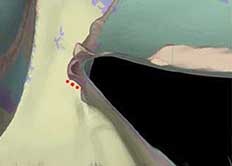Investigating three methods of assessing the clinically relevant trueness of two intraoral scanners

All claims expressed in this article are solely those of the authors and do not necessarily represent those of their affiliated organizations, or those of the publisher, the editors and the reviewers. Any product that may be evaluated in this article or claim that may be made by its manufacturer is not guaranteed or endorsed by the publisher.
Aims Intraoral scanners (IOS) are used for a wide range of treatments. Most IOSs produce data appropriate for local work, such as crowns, but evidence suggests that full-arch scans result in more erroneous scans, which may affect the fit of clinical appliances. There are no standardized methods for assessing the quality of IOSs. Though many studies have investigated the accuracy of scanners, one may find the reported values are difficult to interpret in a clinical context.
Materials and methods This study investigated the trueness of two IOSs, using three metrics. The clinical value of each metric is discussed. A dentate model was scanned 10 times using two intraoral scanners. Three methods were used to assess the trueness of the scans against a scan produced in a laboratory scanner.
Results The mean unsigned distance deviation between a laboratory scan and the Primescan scans was 0.016(±0.006)mm. The mean unsigned distance deviation between the laboratory scan and the Omnicam scans was 0.116(±0.01)mm. The arch width between molars was 55.44mm for the Solutionix scan. The arch width of the Primescan was 55.439(±0.075)mm, while the Omnicam reported 54.672(±0.065)mm. The mean proportion of the Primescan scans deviating beyond 0.1mm when compared against the Solutionix was 0.7(±2.0)%. The equivalent for the Omnicam was 42.1(±2.5)%.
Conclusions All methods indicated significantly different results between the scanners. The Primescan produced truer scans than the Omnicam, regardless of measurement method. The intermolar-width and proportion beyond 0.1mm methods may give more clinically relevant insight into the trueness of scan data than current gold-standard methods.
Copyright (c) 2021 Ariesdue

This work is licensed under a Creative Commons Attribution-NonCommercial 4.0 International License.
The Journal of Osseointegration has chosen to apply the Creative Commons Attribution NonCommercial 4.0 International License (CC BY-NC 4.0) to all manuscripts to be published.


 https://doi.org/10.23805/JO.2020.13.01.5
https://doi.org/10.23805/JO.2020.13.01.5







